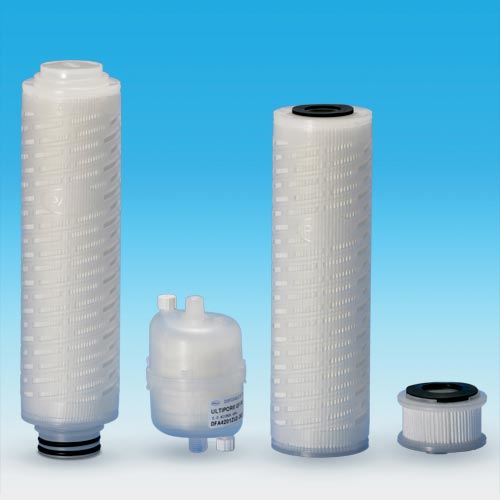Resin-Bonded Fibrous Medium
for Fine Filtration of Ink Jet Inks.
The Ultipor GF Series of filter cartridges is comprised of the Ultipor GF Plus filter, the Ultipor GF-HV filter, and specialty Ultipor GF filters. The specialty filters are the Ultipor GF Plus hot melt ink filter and the Ultipor GF-HV lab test filter.1 Ultipor GF Plus filters are designed for the filtration of low-viscosity fluids and feature very large effective filter areas for low clean pressure drop and long service life. Ultipor GF-HV filters, which are designed for high-viscosity applications, use the same high-performance filter medium as Ultipor GF Plus filters, but in a heavy-duty pleat construction. All of these filters lower processing costs when used with the appropriate fluids. The medium of construction for all Ultipor GF Series filters consists of resin-bonded, inorganic microfibers. It is preferred over melt-blown polypropylene fiber media for ink jet applications where higher temperatures are expected and chemical compatibility with melt-blown polypropylene fiber is a concern. The binder resin, which fully coats the fibers, effectively immobilizes them. This creates a very strong porous structure that, in addition to resisting contaminant unloading and media migration, has exceptional flow characteristics, even at very fine submicron removal ratings.
Features
- Absolute-rated, pleated filters with a resin-bonded microfiber media and polypropylene hardware.2
- Five nominal filter lengths: 43 mm (1.7 in.), 254 mm (10 in.), 508 mm (20 in.), 762 mm (30 in.), and 1016 mm (40 in.).
- Preferred removal ratings: 0.1 μm to 3 μm for Ultipor GF Plus filters, and 0.1 μm to 2 μm for the Ultipor GF-HV filter.3
| Features | Advantages | Benefits |
| Unique matrix with resin-bonded fibers | Robust, fixed pore structure | Resistance to unloading and media migration |
| Filtration to 0.1 μm | Fine filtration of colorant and dispersions | Lower cost filtration than with membrane filters |
| Absolute-rated efficiencies2 | Consistent and effective filter performance | Consistent filtrate results from batch to batch |
| High-area pleated construction (standard for Ultipor GF Plus filters; heavy duty for Ultipor GF-HV filter) | Large effective filter area in a compact configuration | Low pressure drop resulting in longer service life and lower cost per liter |
| Medium incorporates very fine fibers in the media matrix | Very high void volume and porosity | Excellent flow rates, even when filtering to 0.1 μm |
| Incorporated prefilter on 2 μm grade | Protection of final filter layer from premature plugging | Longer service life |
| Lab test filter with small EFA available (Ultipor GF-HV filter only) | Ability to test and scale up filter | Enables understanding and prediction of performance throughout the filtration process |
1 For specific filter recommendations for typical filtration applications, refer to Filtration Solutions for Ink Jet Ink Formulation (1254-B).
For unique applications, consult your Pall representative about recommended filtration products.
2 Absolute rating is based on the modified OSU-F2 test in water, except for the U001Z and U002Z grades, which are based on monodispersed polystyrene latex sphere retention. Contact your Pall representative for more information.
3 Coarser grades are available for other types of applications.
Materials of Construction
| Filter media | Resin-bonded inorganic fiber on polyester substrate |
| Media support/Drainage | Polyester (Ultipor GF Plus filter) Polypropylene (Ultipor GF-HV filter) |
| Core, cage, and end caps | Polypropylene |
| Gaskets/O-rings | Ethylene propylene (EPR) (other options available) |
Operating Conditions
Maximum operating temperature and maximum differential pressures in compatible fluids.4| Operating Temperature | Maximum Differential Pressure |
| AB/MCY Configuration | |
| 20 °C / 68 °F | 5.5 bard / 80 psid |
| 80 °C / 176 °F | 4.1 bard / 60 psid |
| PUY Configuration | |
| 20 °C / 68 °F | 5.5 bard / 80 psid |
| 80 °C / 176 °F | 3.1 bard / 45 psid |
4 Fluids that do not soften, swell or adversely affect the filter or materials of construction.
Filter Selection Based on Fluid Viscosity
Low-Viscosity Fluids
For applications involving the filtration of low-viscosity fluids, Ultipor GF Plus filters are extremely effective and can significantly reduce filtration costs. Each of these filters is designed with a standard pleat structure, tighter pleat spacing, and larger effective filter area, all of which contribute to efficient filtration of low-viscosity fluids. Figure 1 shows the pleat design of the Ultipor GF Plus filter.In a typical low-viscosity application, an Ultipor GF Plus filter will have a lower clean pressure drop and a longer filter life than a heavy-duty pleated filter. This is because of its larger total effective filter area. Figure 2 shows the difference between the life of a filter with a standard, high-area construction and that of a filter with a heavy duty construction, when used with low-viscosity fluids. .
Figure 1: Pleat configuration of Ultipor GF Plus filter
|
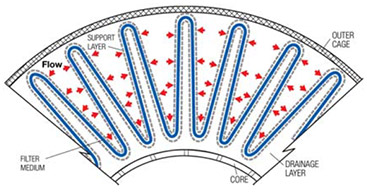
Figure 2: Typical filter life in applications with low-viscosity fluids
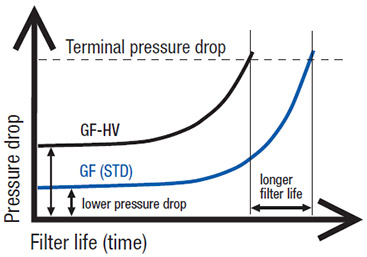
High-Viscosity Fluids
The Ultipor GF-HV filter, with its wider pleat spacing, smaller filter area, and heavy-duty durable pleat support, is well suited for filtration of high-viscosity fluids in high-flow applications. Its heavy-duty pleat construction resists pinching, deformation, and collapse, ensuring even, serial flow throughout the entire pleat depth. The filter’s robust support layers keep the pleats fully open and fully utilized, as shown in Figure 3.In a typical application with a high-viscosity fluid, the Ultipor GF-HV filter has a lower clean pressure drop and a longer filter life than a standard pleated filter. This is the direct result of effective filter media utilization. The benefit is decreased filtration costs in high-viscosity, high-flow applications. Figure 4 shows the difference between the life of a filter with a heavy duty construction and that of a filter with a standard, high-area construction, when used with high-viscosity fluids.
Figure 3: Pleat configuration of Ultipor GF-HV filter
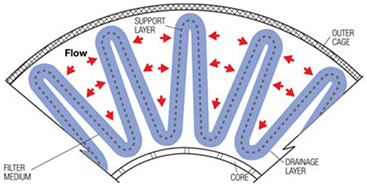
Figure 4: Typical filter life in applications with high-viscosity fluids

Typical Liquid Flow Rate vs. Differential Pressure for AB1/MCY1001 Configuration5
Ultipor GF Filter Grades
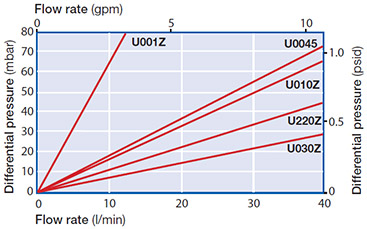
Ultipor GF-HV Filter Grades

5 Flow data is based on water at 20 °C / 68 °F. For liquids with viscosities differing from water, multiply the pressure drop by the viscosity in cP.
Filter Cartridges
Ordering Information / Part Numbers6
Ultipor GF Series filters are available in the following configurations.AB Style – Single-open-ended, 70 mm / 2-3⁄4 in. diameter, with dual external O-ring seals. | MCY1001 Style – Double-openended, 70 mm / 2-3⁄4 in. diameter, with flat gaskets. | PUY Style – Double-open-ended, 64 mm / 2-1⁄2 in diameter, with flat gaskets. | ||
| AB [1] [2] [3] [4] (example: AB1U030Z7J) | MCY100 [1] [2] [4] (example: MCY1001U010ZJ) | PUY [1] [2] [4] (example: PUY1U220ZJ) |
| Code 1 | Nominal Length (mm / in.) |
| 01* | 43 / 1.7 |
| 1 | 254 / 10 |
| 2 | 508 / 20 |
| 3 | 762 / 30 |
| 4 | 1016 / 40 |
*PUY configuration only
| Code 2 | Removal Rating 7 (μm) |
| U001Z | 0.1 |
| U00458 | 0.45 |
| U010Z | 1 |
| U2-20Z | 2 |
| U030Z | 3 |
| Ultipor GF-HV Grades | |
| ZU001Z | 0.1 |
| ZU002Z | 0.2 |
| ZU00458 | 0.45 |
| ZU007Z | 0.7 |
| ZU010Z | 1 |
| ZU220Z | 2 |
| Code 3 | Cartridge Style |
| 3 | Dual 222 size O-rings, flat end |
| 7 | Dual 226 size O-rings, bayonet lock, finned end |
| 8 | Dual 222 size O-rings, finned end |
| Code 4 | Gasket Option |
| J | Ethylene propylene (EPR) |
| Other materials are available on request | |
6 This is a guide to the part numbering structure only. For availability of specific options, please contact your Pall representative.
7 The removal ratings in this publication are based on the modified OSU-F2 test. Contact your Pall representative for additional information.
8 This medium does not feature a positive zeta potential.
Earn 10% off* your next order online by leaving a review of this product. Please login to your account to leave a review. We appreciate and value your feedback.
*Subject to Terms and Conditions.



